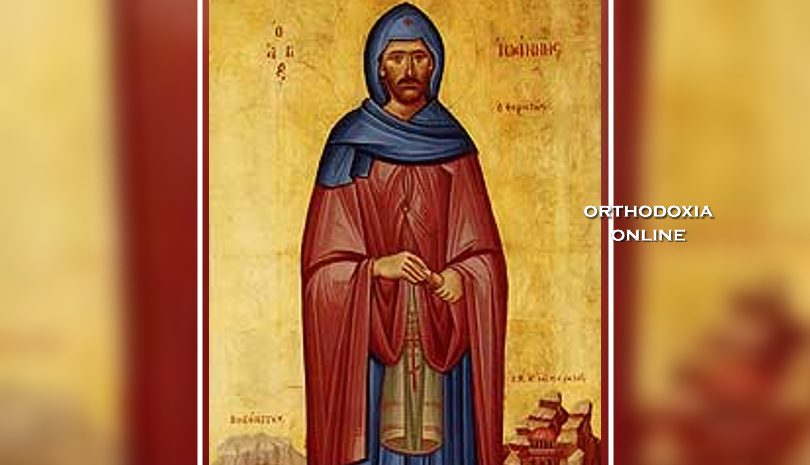Saint John was born around the beginning of the 10th century AD. in Panormo of Sicily. His mother
was an Orthodox Christian captive in the palace of the local Muslim lord, who had her as his wife and
was named Callisti.
The saint grew up according to the customs of the Saracens. Only his mother spoke to him in secret
from his childhood about Christ. When he reached the age of 14, he revealed to him his true
homeland, Calabria and urged him to go there to be baptized Orthodox Christian. Then the pious
Callisti embraced her child and gave him the Holy Cross, which she secretly kept and was her only
consolation in the sorrows of her captivity. Saint John miraculously escaped the pursuit of the
Agarines (the Muslim, the infidels) and landed on the coast of Stylus, where he was baptized by the
Orthodox Bishop John, who gave him his name. He then followed the solitary life and attained high
measures of virtue and holiness.
John regularly went to the Church, worshiped the Holy Cross and asked for explanations for the holy
icons he saw. Seeing next to Christ the Holy Saint John the Forerunner, he asked: "Who is this Saint
who is dressed in a camel's skin?". They answered him: "It is John the Forerunner, the prophet who
lived in the desert. He is the one who baptized our Christ in the Jordan River. Imitate him, because
you have his name." Hearing the life of the Saint John the Forerunner was filled with divine desire
and begged the Bishop to show him a deserted place where he could save his soul. He then pointed
out to him an ancient monastery in a forest valley, between the rivers Assis and Stylaros. He went
there and found two holy monks, Ambrose and Nicholas. At first, they were negative and left him
outside the door of the monastery, until, admiring his stability and perseverance, they accepted him
and he began the angelic life and reach the heights of holiness.
Once upon a time in Roviano, on the Monasterace side, there was a benefactor who every year,
after the harvest, gave a little to the monastery. During the month June, John went to find him,
taking with him a small bottle of wine. As he passed through the fields, the villagers began to tease
him, but the meek John approached them and gave them all to eat and drink. Everyone ate the
bread and drank the wine, but the bread did not run out, nor did the winepress run out. As soon as
he saw this the Saint was kneeling and thanking God when suddenly, at noon, the sky darkened and
a storm fell on the plain. The harvesters ran for cover. Only John remained there praying. As soon as
the rain stopped, the harvesters returned to their work and found all the sheaves harvested, tied in
bundles and dry. That is why he was called the Harvester.
The Saint predicted his death (called sleep in orthodoxy), and his holy relic became a source of
miracles and healings everywhere, so that even the Frank conquerors erected a magnificent temple
in his honour. Since then, however, the Latinization of the area began and so the last Latin monks
left the monastery and moved to Stylos, bringing there with them, where they are preserved to this
day, the holy relics of Saints John, Ambrose and Nikolaos, his teachers.
There is no record of the exact date on which the Blessed One slept in peace and rested in
Abraham's bosom. Tradition wants the feast of the memory of the Saint on this day, along with the
feast of the finding of the Holy head of Saint John the Forerunner, because Saint John was a
forerunner of salvation, a new forerunner of the kingdom of heaven.
Translated for the Orthodox Path from original Greek text
Greek source: https://www.saint.gr/2510/saint.aspx
Saint John the Theristis (Harvester) of Calabria

